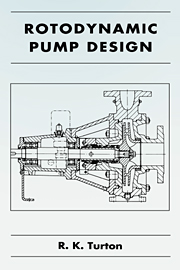Book contents
- Frontmatter
- Contents
- Preface
- Symbols
- 1 Fundamental principles
- 2 Cavitation in pumps
- 3 Centrifugal pump principles
- 4 Principles of axial and mixed flow pumps
- 5 Flow calculations in pumps and an introduction to computer aided techniques
- 6 Single stage centrifugal pump design
- 7 The design of axial and mixed flow pumps
- 8 Basic design principles of shafts, bearings and seals, and selection of drive
- 9 Pump design for difficult applications
- 10 An introduction to the next stage in the pump design process
- References
- Index
8 - Basic design principles of shafts, bearings and seals, and selection of drive
Published online by Cambridge University Press: 29 September 2009
- Frontmatter
- Contents
- Preface
- Symbols
- 1 Fundamental principles
- 2 Cavitation in pumps
- 3 Centrifugal pump principles
- 4 Principles of axial and mixed flow pumps
- 5 Flow calculations in pumps and an introduction to computer aided techniques
- 6 Single stage centrifugal pump design
- 7 The design of axial and mixed flow pumps
- 8 Basic design principles of shafts, bearings and seals, and selection of drive
- 9 Pump design for difficult applications
- 10 An introduction to the next stage in the pump design process
- References
- Index
Summary
Introduction
It is not possible to cover anything in this book but the most basic considerations that underly the choice of shaft bearing seal and drive, so that the reader is referred to the literature and to pump handbooks that give more information. In this chapter the very basic principles are introduced, and the conventional terms used are defined.
Shaft design is first introduced, it being commented that this must involve the whole rotating system. Rolling element and plain bearings are then discussed, the basic seal designs are introduced and some design rules for good service are outlined. The chapter concludes with references to the selection of drive arrangement.
Shaft design
The shaft in a pump must sustain torsional effects, bending forces due to both the mechanical parts and hydraulic loads, and axial loads due to weight in the vertical plane and to hydraulic loads.
The empirical approach to shaft design is well documented in such texts as Stepannof (1976), Karassik et al. (1976) and the engineering handbooks. If the weight of the impeller system is known, and the axial and radial hydraulic loads determined, the shaft sizes can be determined and checked. Consider Figure 8.1, showing the rotating assembly for a horizontal centrifugal pump. Simple statics allow the determination of the reactions R1 and R2 and the resulting moment applied to the bearing system can be calculated.
- Type
- Chapter
- Information
- Rotodynamic Pump Design , pp. 140 - 160Publisher: Cambridge University PressPrint publication year: 1994



